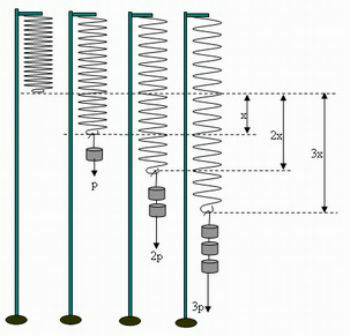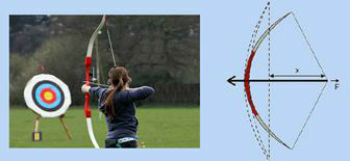Hooke's Law is a law of physics that determines the deformation undergone by an elastic body through a force.
The theory states that the stretch of an elastic object is directly proportional to the force applied to it.
As an example, we can think of a spring. When stretching it, it exerts a force contrary to the movement performed. Thus, the greater the applied force, the greater will be its deformation.
On the other hand, when the spring does not have a force acting on it, we say that it is in balance.
Did you know?
Hooke's Law is named after the English scientist Robert Hooke (1635-1703).
Formula
Hooke's Law formula is expressed as follows:
F = k. there
from where,
F: force applied to the elastic body
K: elastic constant or proportionality constant
there: independent variable, that is, the deformation suffered
According to the International System (SI), the force (F) is measured in Newton (N), the elastic constant (K) in Newton per meter (N/m) and the variable (Δl) in meters (m).
Note: The variation of the deformation suffered
Δl = L - L0, may be indicated by x. Note that L is the final length of the spring and L0, the initial length.Hooke's Law Experiment
To confirm Hooke's Law we can perform a small experiment with a spring attached to a support.
When pulling it, we can see that the force we apply to stretch it is directly proportional to the force it exerts, but in the opposite direction.
In other words, the deformation of the spring increases in proportion to the force applied to it.

Graphic
To better understand Hooke's Law experiment a table is made. Notice that Δl or x corresponds to the deformation of the spring, and For P corresponds to the force that the weights exert on the spring.
Thus, if P = 50N and x = 5 m, we have:
| F (N) | 50 | 100 | 150 |
|---|---|---|---|
| x (m) | 5 | 10 | 15 |
After noting the values, we plot F versus x.

Entrance Exam Exercises with Feedback
1. (UFSM) During strength exercises performed by a runner, a rubber band attached to their abdomen is used. In starts, the athlete obtains the following results:
| Week | 1 | 2 | 3 | 4 | 5 |
|---|---|---|---|---|---|
| Δx (cm) | 20 | 24 | 26 | 27 | 28 |
The maximum force reached by the athlete, knowing that the elastic constant of the strap is 300 N/m and that it obeys Hooke's law, is, in N:
a) 23520
b) 17600
c) 1760
d) 840
e) 84
Alternative and
2. (UFU-MG) Archery has been an Olympic sport since the second Olympics in Paris, in 1900. The bow is a device that converts elastic potential energy, stored when the bowstring is tensioned, into kinetic energy, which is transferred to the arrow.

In an experiment, we measure the force F necessary to tension the bow to a certain distance x, obtaining the following values:
| F (N) | 160 | 320 | 480 |
|---|---|---|---|
| x (cm) | 10 | 20 | 30 |
The value and units of the elastic constant, k, of the arc are:
a) 16 m/N
b) 1.6 kN/m
c) 35 N/m
d) 5/8 x 10-2 m/N
Alternative b
3. (UFRJ-RJ) The system represented in the figure (trolleys of the same mass connected to identical springs) is initially at rest and can move with negligible friction on horizontal rails:

A constant force is applied to the free end of spring 3, parallel to the rails and oriented to the right. After the initial oscillations have been damped, the assembly moves in a block to the right. In this situation, where l1, l2 and l3 are the respective lengths of springs 1, 2 and 3, mark the correct alternative:
a) l1 > l2 > l3
b) l1 = l2 = l3
c) l1 d) l1 = l2 e) l1 = l2 > l3
Alternative c
Want to know more? Also read the articles:
- Strength
- Elastic strength
- Potential energy
- Elastic Potential Energy



